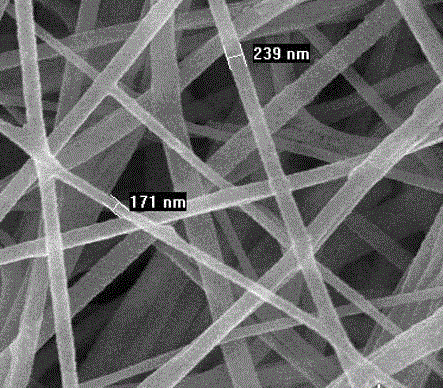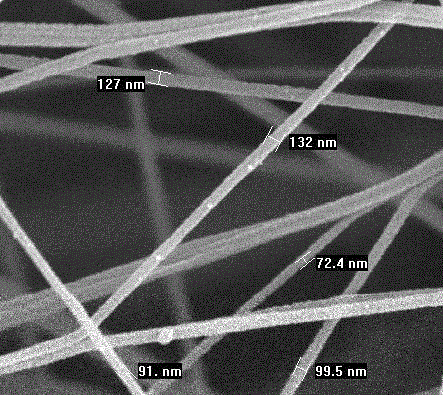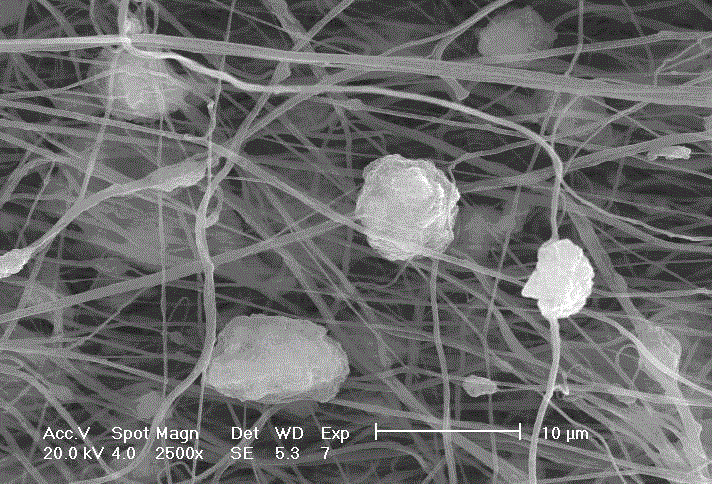A kind of preparation method and application of polym-phenylene isophthalamide-polyacrylonitrile composite nanofiber membrane
A poly-m-phenylene isophthalamide and composite nanofiber technology is applied in fiber processing, single-component halogenated hydrocarbon man-made filament, filament/thread forming, etc., which can solve the cumbersome process of immobilizing enzymes, Low mechanical strength, difficult to recycle, etc., to achieve the effect of improving the utilization rate of enzymes, high mechanical strength, and easy recovery
- Summary
- Abstract
- Description
- Claims
- Application Information
AI Technical Summary
Problems solved by technology
Method used
Image
Examples
Embodiment 1
[0030] 1. Dissolving the polym-phenylene isophthalamide polymer in N,N-dimethylacetamide solution (containing 8% lithium chloride by mass percentage) to form a solution with a mass percentage of 5%, Dissolve polyacrylonitrile in N,N-dimethylacetamide solution to prepare a 5% solution by mass. The above-mentioned polym-phenylene isophthalamide and polyacrylonitrile solution were blended to form a solution with a mass ratio of 1:3, and injected into the electrospinning device. Electrospinning was carried out under the conditions of a voltage of 16kV, a spinneret solution flow rate of 1mL / h, a receiving distance of 10cm, and a drum speed of 200r / min to obtain polyisophthalamide with a fiber diameter of about 200nm. For the amine-polyacrylonitrile nanofiber membrane, immerse the nanofiber membrane in distilled water for 2 hours, take out the membrane and dry it in a vacuum oven at 80°C for 12 hours. figure 1 Shown is the SEM characterization diagram of the prepared composite nan...
Embodiment 2
[0033] 1. Dissolve polym-phenylene isophthalamide polymer in N,N-dimethylacetamide solution (containing 10% lithium chloride by mass percentage) to form a 5% solution by mass, Dissolve polyacrylonitrile in N,N-dimethylacetamide solution to prepare a 5% solution by mass. The above-mentioned polym-phenylene isophthalamide and polyacrylonitrile solution were blended to form a solution with a mass ratio of 3:1, and injected into the electrospinning device. Electrospinning was carried out under the conditions of a voltage of 16 kV, a spinneret solution flow rate of 0.5 mL / h, a receiving distance of 10 cm, and a drum speed of 500 r / min to obtain polyisophthalamide with a fiber diameter of about 100 nm. For the m-phenylenediamine-polyacrylonitrile nanofiber membrane, immerse the nanofiber membrane in distilled water for 2 hours, take out the membrane and dry it in a vacuum oven at 60°C for 12 hours. figure 2 Shown is the SEM characterization of the prepared composite nanofibrous me...
PUM
| Property | Measurement | Unit |
|---|---|---|
| diameter | aaaaa | aaaaa |
| diameter | aaaaa | aaaaa |
| diameter | aaaaa | aaaaa |
Abstract
Description
Claims
Application Information
 Login to View More
Login to View More - R&D
- Intellectual Property
- Life Sciences
- Materials
- Tech Scout
- Unparalleled Data Quality
- Higher Quality Content
- 60% Fewer Hallucinations
Browse by: Latest US Patents, China's latest patents, Technical Efficacy Thesaurus, Application Domain, Technology Topic, Popular Technical Reports.
© 2025 PatSnap. All rights reserved.Legal|Privacy policy|Modern Slavery Act Transparency Statement|Sitemap|About US| Contact US: help@patsnap.com



